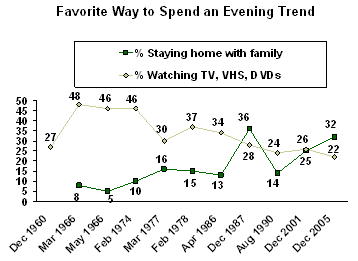GALLUP NEWS SERVICE
PRINCETON, NJ -- Gallup's annual Lifestyle poll asked Americans, without prompting, to name their favorite way to spend an evening. Nearly one in three Americans say their ideal evening is spent at home with family, making that activity the most popular, followed by watching television. These two activities have traditionally ranked as Americans' favorite ways to spend the evening. Family and friends rank first with younger adults, while watching television ranks first among older adults. Employed adults also prefer time with the family, while those who are not employed prefer to watch television.
The poll, conducted Dec. 5-8, 2005, finds that 32% of Americans say staying at home with the family is their favorite way to spend an evening, while 22% mention watching television, and 11% say reading. Other favored ways to spend the evening include resting or relaxing (8%), dining out (6%), entertaining or visiting friends (4%), or going to the movies or theater (4%).

Since this question was first asked in 1960, spending time with family and watching television have alternated as Americans' favorite ways to spend their evenings.

From 1960 until 1987, watching television topped the list, reaching a high point of 48% in 1966. In 1987, family won out over television, while three years later television came in first, and in 2001 television and family tied for the most popular ways to spend the evening. The current increase in the percentage of Americans saying their preferred way to spend an evening is staying home with family does not necessarily mean that people are not watching television or movies together as a family, but rather, the phrase "staying at home with the family" has become more prevalent, perhaps indicating a renewed interest in having quality family time.
Over the years, reading has been another favored way for many Americans to spend their evenings. Only 10% mentioned the activity in 1960, but the number increased to a high of 17% in the late-1970s. Since 1990, this percentage has shown only modest fluctuations, ranging between 9% and 15%.
Younger vs. Older Americans' Favorite Ways to Spend an Evening
Younger Americans and older Americans differ in their views of the best way to spend an evening, with younger adults more likely to want to spend time with family and friends and older adults more likely to want to watch television or to read.
Four in 10 of adults 50 years or younger (41% of 18- to 29-year-olds and 42% of 30- to 49-year-olds) say their ideal evening is spending time with family. This percentage is lower among those aged 50 to 64, at 24%, and those aged 65 and older, at 16%.
Adults in the 18 to 29 age group are most likely to mention visiting with friends. Ten percent of adults in this age range mention this, compared with 2% of 30- to 49-year-olds, 3% of 50- to 64-year-olds, and 5% of adults aged 65 and older.
Just 14% of 18- to 29-year-olds say watching television is their favorite way to spend an evening. This compares with 19% among those 30 to 49 years old, 26% among those 50 to 64 years old, and 34% among those aged 65 and older.
Older Americans are more inclined to mention reading as their favorite way to spend an evening. Nineteen percent of those 65 and older do so, compared with 13% of 50- to 64-year-olds, 7% of 30- to 49-year-olds, and 8% of 18- to 29-year-olds.
Employed vs. Non-Employed Adults' Ideal Evening
The ideal way to spend an evening varies between those who are employed and those who are not employed. Thirty-seven percent of employed adults say their favorite way to spend the evening is staying at home with family, while 18% say watching television. Among those who are not employed, 30% prefer to watch television, while 24% prefer staying home with family.
Survey Methods
Results are based on telephone interviews with 1,013 national adults, aged 18 and older, conducted Dec. 5-8, 2005. For results based on the total sample of national adults, one can say with 95% confidence that the maximum margin of sampling error is 卤3 percentage points. In addition to sampling error, question wording and practical difficulties in conducting surveys can introduce error or bias into the findings of public opinion polls.